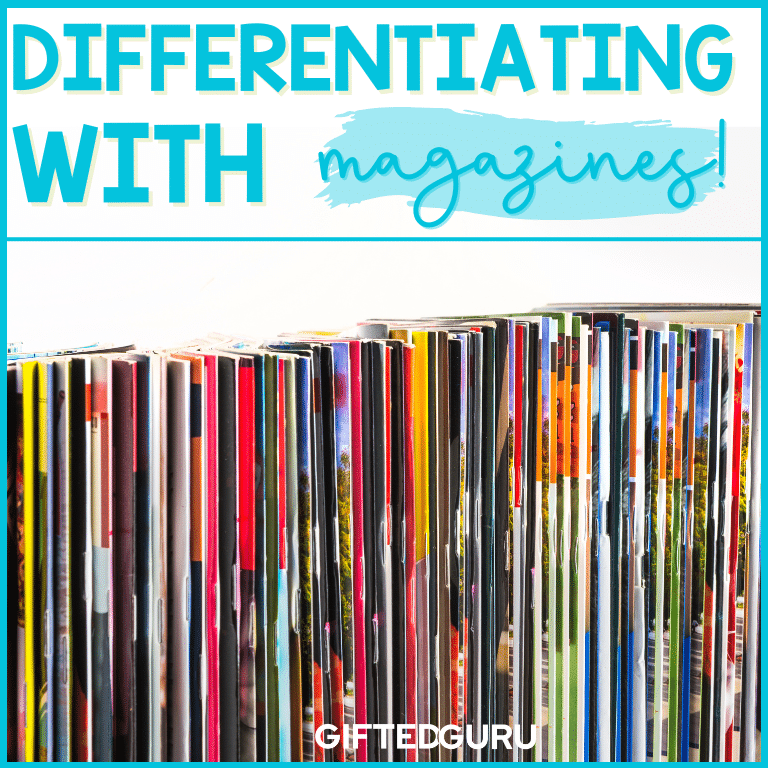One of the most effective things a teacher can differentiate is the environment.
There are a lot of ways to do that, and one of them is to use magazines.
The good news is that it is very easy!
If you’ve been put off of the idea of differentiation because it seems really hard and that it will take a long time, you can start here with this simple idea.
This works great for homeschools, too!
What Magazines Can Do
I’ve used magazines to accomplish all of these things in my classroom:
- create diversity
- differentiate for interest
- provide students with writing ideas
- supply authentic sources for exemplars
- content for sponge activities and for early finishers
I’m going to focus on using magazines to differentiate the environment for interest.
Matching Interests
When I began teaching, I was shocked at how much I spent on my classroom (over $1,500 the first year, and that was decades ago!). I started looking for inexpensive solutions, and magazines were one of my most effective finds.
I wanted to make sure that students had resources in the classroom that aligned with their interests. These interests were not necessarily my interests, and they weren’t necessarily obvious or intuitive. One of my students’ favorites? Lob Cabin Living. Really?
I had students who were interested in everything from boats to bikes to sports to jewelry to dinosaurs to writing to computers and on and on.
It turns out that there are magazines for every possible topic of interest, even for gifted kids and their esoteric interests!
Magazines are a great resource because they resupply themselves. They are timely. They are lightweight.
Tips for Bringing Magazines into Your Classroom Effectively
- Survey students for interests. You may want to show some magazines to gauge interest. Feel free to order magazines that appeal to only one student!
- Take a risk if you find a cheap price. Even if no one has expressed an interest in log homes, if you find a magazine for $3/year, why not try?
- Print labels with your name and classroom number (“Please return to Mrs. Van in Room 231”) and put them on the cover and the table of contents page. (That’s my actual room number!)
- If a magazine is really popular, you may wish to order multiple copies of that one, as they may miraculously disappear…
- If another teacher is using magazines, too, consider rotating to get double the magazines
Display Them
Decide on a storage solution. There are tons of magazine racks available from a ton of sources.
I love it when the magazine covers are showing (and your students will, too).
- If that’s not possible, you can store them in anything from cereal boxes cut off at an angle (free) to magazine file boxes from IKEA (very inexpensive).
- Even one of those over-the-door shoe holders with pockets work great. They can be hung on the wall with sticky hooks.
- You can put the magazines in a filing cabinet drawer, hanging them over hanging file folders.
- If you have a little extra cash and a little time, there are a number of ways to create DIY magazine displays.
- My favorite way to store them is to use milk crates. I tape hanging file folders shut with clear packing tape, and then I hang the magazine over the hanging file folder so the spine is showing.
Where I Get My Magazines
You can spend a fortune on magazines, especially if you buy them off the newsstand.
I get mine in four main ways:
- You can add things to your Amazon Wish List that aren’t actually on Amazon, so you can link to magazines you would like.
- There are discount sites like this one.
- You can get used magazines at thrift shops, library sales, and used book stores.
- You can also just post on your personal social media and ask if anyone has magazines they’re willing to give to your class when they’re done with them.
Set Expectations
When you first bring magazines into the classroom, share with students how to care for them. Whatever your expectations are, make sure they’re clear. You can even create a care label for them to print out and stick on the cover
Some reasonable expectations are:
- Turn pages slowly enough not to rip the pages
- Fold pages back carefully enough that the binding doesn’t break
- Use a bookmark rather than folding over the corner of the page
- Return the magazine carefully to its home
I hope you’ll find magazines as easy and effective a way to help differentiate your classroom environment as I did!
Become a Differentiation Master
If you’re ready to build a systematic approach to differentiation that works for your classroom, your content, and your students, I’d love to have you join my Differentiation Professional Development Course.
It’s designed for real teachers in real classrooms who need practical strategies that actually work—not theoretical frameworks that look good on paper but fall apart by third period.
You’ll learn how to:
- Plan differentiated lessons from the start (instead of scrambling to add them later)
- Assess readiness, interest, and learning profile efficiently
- Create tiered assignments that genuinely challenge all learners
- Manage a differentiated classroom without losing your mind
Because at the end of the day, gifted kids deserve to learn something new. And you deserve strategies that make that possible without adding three hours to your evening.
Let’s make it happen.
Can we be inbox friends?
You’ll get tips for teachers & parents of gifted kids, ideas, freebies, and the inside scoop on new resources (with super great sales of course).
You can unsubscribe anytime (but I hope you won’t because I love sharing great stuff!)
~ Lisa
Thank you!
You’re in the incrowd now!
Here are links to the files:
* 15 Ways to Help Gifted Kids Thrive in School
If you’re on Instagram, let’s connect!
See you soon,
~Lisa




